
The Blizzard of 2003, also known as the Presidents' Day Storm II or simply PDII, was an historic and record-breaking snowstorm on the East Coast of the United States and Canada, which lasted from February 14 to February 19, 2003. It spread heavy snow across the major cities of the Northeastern and Mid-Atlantic states, making it the defining snowstorm of the very snowy winter of 2002-2003.
The January 2007 North American ice storm was a severe ice storm that affected a large swath of North America from the Rio Grande Valley to New England and southeastern Canada, starting on January 11 and lasting until January 16. It was followed by a second wave in the Southern United States from Texas to the Carolinas from January 16 through January 18, and a third one that hit the southern Plains and mid-Atlantic states as well as Newfoundland and Labrador from January 19 to January 24. It resulted in at least 74 deaths across 12 U.S. states and three Canadian provinces, and caused hundreds of thousands of residents across the U.S. and Canada to lose electric power.

The February 2007 North American blizzard was a massive winter storm that affected most of the eastern half of North America, starting on February 12, 2007 and peaking on Valentine's Day, February 14. The storm produced heavy snowfalls across the midwestern United States from Nebraska to Ohio and produced similar conditions across parts of the northeastern United States, and into Canada in Ontario, Quebec and New Brunswick. Significant sleet and freezing rain fell across the southern Ohio Valley and affected portions of the east coast of the United States, including the cities of Boston, Baltimore, Washington, D.C., New York City and Philadelphia.
The Early December 2007 North American winter storm was a major winter storm which affected the majority of the United States and portions of southern Canada from November 29 to December 5, hitting the Intermountain West and Midwestern United States, the Great Lakes region and the Northeast. The storm brought significant snows to portions of the Upper Midwest, Great Plains and Great Lakes regions of the United States and Canada on December 1 with a major winter storm for Quebec, Ontario and parts of the Northeast region on December 2 and 3 as well as the Canadian Maritimes on December 4 and 5. The system was also responsible for a major ice storm across the Midwestern states which caused disruptions to several major cities including Des Moines, Chicago, Detroit, Milwaukee and Toronto. The storm was blamed for at least 16 deaths across nine US states and one Canadian province. 10 traffic deaths had been reported, as of 2 December 2007.

The Mid-December 2007 North American winter storms were a series of winter storms that affected much of central and eastern North America, from December 8 to December 18, 2007. The systems affected areas from Oklahoma to Newfoundland and Labrador with freezing rain, thunderstorms, sleet, snow, damaging winds, and blizzard-like conditions in various areas. The first two storms produced copious amounts of ice across the Midwestern United States and Great Plains from December 8 to December 11, knocking out power to approximately 1.5 million customers from Oklahoma north to Iowa. The second storm moved northeast, producing heavy snow across New York and New England. A third storm was responsible for a major winter storm from Kansas to the Canadian Maritimes, bringing locally record-breaking snowfalls to Ontario, an icestorm across the Appalachians, and thunderstorms and tornadoes to the Southeastern United States.
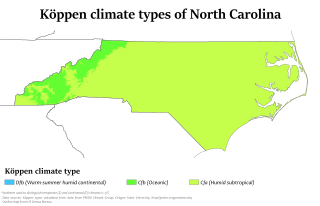
North Carolina's climate varies from the Atlantic coast in the east to the Appalachian Mountain range in the west. The mountains often act as a "shield", blocking low temperatures and storms from the Midwest from entering the Piedmont of North Carolina.

The North American blizzard of 2008 was a winter storm that struck most of southern and eastern North America from March 6 to March 10, 2008. The storm was most notable for a major winter storm event from Arkansas to Quebec. It also produced severe weather across the east coast of the United States with heavy rain, damaging winds and tornadoes, causing locally significant damage. The hardest hit areas by the wintry weather were from the Ohio Valley to southern Quebec where up to a half a meter of snow fell locally including the major cities of Columbus, Ohio, Cleveland, Ohio, and Ottawa, Ontario. For many areas across portions of the central United States, Ontario and Quebec, it was the worst winter storm in the past several years. The blizzard and its aftermath caused at least 17 deaths across four US states and three Canadian provinces, while hundreds others were injured mostly in weather-related accidents and tornadoes.

The Carolina Crusher was one of the most powerful winter storms on record in parts of North Carolina. The storm hit Central Virginia on January 25, 2000 causing thousands of power outages within the area leaving 11 inches in Richmond, VA and 20.3 inches in Raleigh-Durham International Airport before moving out to the Atlantic.
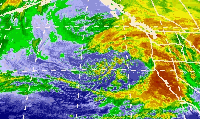
The October 2009 North American storm complex was a powerful extratropical cyclone that was associated with the remnants of Typhoon Melor, which brought extreme amounts of rainfall to California. The system started out as a weak area of low pressure, that formed in the northern Gulf of Alaska on October 7. Late on October 11, the system quickly absorbed Melor's remnant moisture, which resulted in the system strengthening significantly offshore, before moving southeastward to impact the West Coast of the United States, beginning very early on October 13. Around the same time, an atmospheric river opened up, channeling large amounts of moisture into the storm, resulting in heavy rainfall across California and other parts of the Western United States.
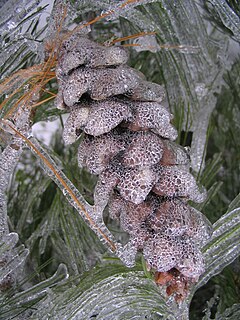
Global storm activity of 2008 profiles the major worldwide storms, including blizzards, ice storms, and other winter events, from January 1, 2008 to December 31, 2008. A winter storm is an event in which the dominant varieties of precipitation are forms that only occur at cold temperatures, such as snow or sleet, or a rainstorm where ground temperatures are cold enough to allow ice to form. It may be marked by strong wind, thunder and lightning, heavy precipitation, such as ice, or wind transporting some substance through the atmosphere. Major dust storms, Hurricanes, cyclones, tornados, gales, flooding and rainstorms are also caused by such phenomena to a lesser or greater existent.

Global storm activity of 2007 profiles the major worldwide storms, including blizzards, ice storms, and other winter events, from January 1, 2007, to December 31, 2007. Winter storms are events in which the dominant varieties of precipitation are forms that only occur at cold temperatures, such as snow or sleet, or a rainstorm where ground temperatures are cold enough to allow ice to form. It may be marked by strong wind, thunder and lightning, heavy precipitation, such as ice, or wind transporting some substance through the atmosphere. Other major non winter events such as large dust storms, Hurricanes, cyclones, tornados, gales, flooding and rainstorms are also caused by such phenomena to a lesser or greater existent.
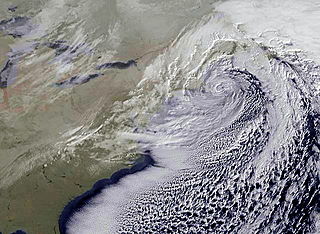
The December 2010 North American blizzard was a major nor'easter and historic blizzard affecting the Contiguous United States and portions of Canada from December 5–29, 2010. From January 4–15, the system was known as Windstorm Benjamin in Europe. It was the first significant winter storm of the 2010–11 North American winter storm season and the fifth North American blizzard of 2010. The storm system affected the northeast megalopolis, which includes major cities such as Norfolk, Philadelphia, Newark, New York City, Hartford, Providence, and Boston. The storm brought between 12 and 32 inches of snow in many of these areas.

The December 1969 nor'easter was a strong winter storm that mainly affected the Northeastern United States and southern Quebec between December 25 and December 28, 1969. The multi-faceted storm system included a tornado outbreak, record snow accumulations, a damaging ice storm, and flooding rains.

The January 8–13, 2011 North American Blizzard was a major Mid-Atlantic nor'easter and winter storm, and a New England blizzard. The storm also affected portions of the Southeastern regions of the United States. This storm came just two weeks after a previous major blizzard severely affected most of these same areas in December 2010. It was the second significant snowstorm to affect the region during the 2010–11 North American winter storm season.

The December 17–22, 2012 North American blizzard was a winter storm that affected the Midwestern and Eastern United States. Forming on December 17, the winter storm moved across the midwest, forcing schools to close throughout the region. Numerous warnings and advisories had been posted by the National Weather Service for many states, including Iowa, Nebraska, Illinois, and Wisconsin. Both O'Hare International Airport and Midway International Airport in Chicago, Illinois canceled most departures and arrivals. According to flight tracking website FlightStats.com, more than 1,000 flights were canceled across the region. More than 130,000 customers were without power across the west and midwest.

The 2013–14 North American winter refers to winter in North America as it occurred across the continent from late 2013 through early 2014. The winter of 2013–14 was one of the most significant for the United States, due in part to the breakdown of the polar vortex in November 2013, which allowed very cold air to travel down into the United States, leading to an extended period of very cold temperatures. The pattern continued mostly uninterrupted throughout the winter and numerous significant winter storms affected the Eastern United States, with the most notable one being a powerful winter storm that dumped ice and snow in the Southeast and Northeast in mid-February. Most of the cold weather abated by the end of March, though a few winter storms did affect the western portions of the U.S. towards the end of the winter.
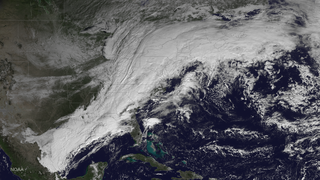
From November 13–21, 2014, a potent winter storm and particularly severe lake-effect snowstorm affected the United States, originating from the Pacific Northwest on November 13, which brought copious amounts of lake-effect snow to the Central US and New England from November 15 until November 21, when the system departed the East Coast of the United States. The snowstorm elicited an enormous response from emergency crews and the National Guard, requiring more manpower than any other snowstorm in the history of New York state as it buried cars and stranded thousands of people in their homes in Western New York. Eight months after the storm, the snow's remnants still remained in Buffalo, New York.

The February 2016 North American winter storm was a strong winter storm that caused more than 70,000 people in southern California to lose their electricity, with many broken trees and electrical lines in that area, with the Southern Rocky Mountains having the potential to receive some of the greatest snowfall from the system. One person in San Diego, California area died when a tree fell on their car. Another person in Minnesota died after being struck by a car while crossing a street.

The early January 2017 North American winter storm was a major snow and ice storm that affected the Lower 48 of the United States with severe weather. Moving ashore on the West Coast on January 3, the system produced heavy snowfall in the Sierra Mountains, with nearly 4 feet of snowfall falling in the highest elevations. After impacting the Northwest and Southwest, the winter storm went on to strike the Southeast on January 5–6 with snow and ice, with snowfall accumulations up to 4 inches (10 cm). Afterwards, it began to morph into a nor'easter as it moved off the Southeast coast late on January 6, while producing blizzard conditions in the Carolinas. It then began to affect the Northeastern United States as it tracked northwards early on January 7. It produced a swath of moderate snowfall accumulations up the East Coast, with easternmost areas such as parts of Massachusetts receiving up to 1.5 feet (18 in) of snow.
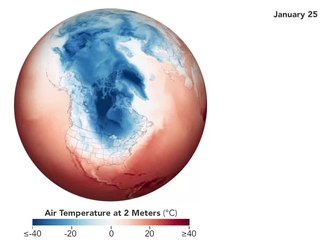
The 2018–19 North American winter refers to winter in North America as it occurred across the continent from late 2018 through early 2019. Notable events have included a rare snow in the Southeast in December, a strong cold wave and several major winter storms in the Midwest, and upper Northeast and much of Canada late January and early February, record snowstorms in the Southwest late February, two nor'easters that affected the east coast early March, deadly tornado outbreaks in the Southeast, collapsing buildings in Quebec, a historic mid-April blizzard in the Midwest, but the most notable event all season was a record-breaking bomb cyclone that affected much of central USA and Canada in mid March. Unlike previous winters, a developing El Niño was expected to influence weather patterns across North America. Overall, however, winter of 2018 - 2019 was mild along the mid and lower East Coast, West Coast, and most of the southern Plains.




















